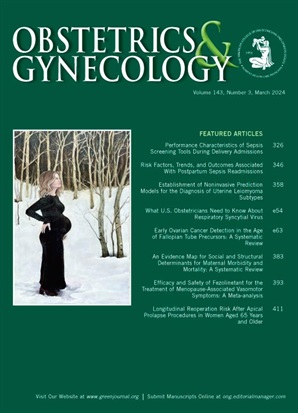Prediction of Treatment Failure After Excisional Treatment of Cervical Precancer: A Systematic Review and Meta-analysis.
IF 4.7
2区 医学
Q1 OBSTETRICS & GYNECOLOGY
引用次数: 0
Abstract
OBJECTIVE To evaluate the diagnostic accuracy and clinical utility of posttreatment tests to predict treatment failure after excisional treatment of cervical intraepithelial neoplasia grade 2 or worse (CIN 2+). DATA SOURCES Electronic databases (EMBASE, PubMed MEDLINE) were searched for studies published from January 1975 to August 2024 assessing the occurrence of treatment failure in women who underwent excisional treatment for histologically confirmed CIN 2+ lesion. METHODS OF STUDY SELECTION Previously published meta-analyses were extended and updated. A total of 1,802 studies were reviewed. Studies that assessed the diagnostic accuracy of the margin status, cytologic testing, combination of cytology and high-risk human papillomavirus (HPV), or combination of margin status and high-risk HPV compared with high-risk HPV testing were included. The primary outcome was treatment failure (residual or recurrent CIN 2+) and the absolute and relative diagnostic accuracy to predict this outcome. Studies with at least 18 months of follow-up were included. TABULATION, INTEGRATION, AND RESULTS Forty-six studies and 20,385 women were included in the analysis. Treatment failure occurred in 6.6% of patients. The pooled sensitivity and specificity of high-risk HPV testing were 86.8% and 80.5%, respectively. Cytology had a sensitivity of 70.8% and a specificity of 85.7%, pooled from 34 studies. Compared with high-risk HPV testing in the same studies, cytology was 6.5% more specific (95% CI, 1.024-1.108) but 21.3% less sensitive (95% CI, 0.702-0.882). Assessment of the margin status was 39.9% less sensitive (95% CI, 0.532-0.678) but similarly specific (95% CI, 0.970-1.069) to high-risk HPV testing in 29 studies, with a pooled sensitivity and specificity of 48.9% and 82.5%, respectively. Co-testing with cytology and high-risk HPV was similarly sensitive (95% CI, 0.992-1.061) but 10.5% less specific (95% CI, 0.850-0.944) compared with high-risk HPV testing in 16 studies, with a pooled sensitivity and specificity of 94.7% and 69.9%, respectively. The pooled sensitivity and specificity of co-testing with margin status and high-risk HPV were 96.9% and 55.7%, respectively, 6.6% more sensitive (95% CI, 1.021-1.114) but 26.7% less specific (95% CI, 0.637-0.844) than high-risk HPV testing in eight studies. Involved resection margins, abnormal cytology, and a positive high-risk HPV test result were associated with a failure risk of 16.1%, 29.0%, and 26.1%, respectively. Women with negative margins, normal cytology, and a negative high-risk HPV test result had a failure risk of 3.6%, 2.3%, and 0.9%, respectively. The risk of treatment failure was highest for women with involved margins and a positive high-risk HPV test result (45.3%) and lowest for women with negative margins and a negative high-risk HPV test result (0.3%). Abnormal cytology and a positive high-risk HPV test result increased the risk of treatment failure to 42%, whereas normal cytology and a negative high-risk HPV test result decreased the risk to 0.6%. CONCLUSION High-risk HPV testing is highly sensitive and specific to predict residual or recurrent CIN 2+ after excisional treatment. Cytologic testing and assessment of the margin status are slightly more and similarly specific, respectively, but both are significantly less sensitive. High-risk HPV testing can sufficiently inform the posttreatment management based on the posttest risk of treatment failure, unlike both cytology and assessment of the margin status. High-risk HPV testing alone performs similarly to co-testing with cytology or margin status. Posttreatment high-risk HPV testing is therefore an accurate predictor of treatment failure in women treated for CIN 2+.宫颈癌前病变切除术后治疗失败的预测:一项系统综述和荟萃分析。
目的评价宫颈上皮内瘤变2级及以上(CIN 2+)切除术后治疗失败的诊断准确性和临床应用。数据来源检索电子数据库(EMBASE, PubMed MEDLINE),检索1975年1月至2024年8月发表的研究,评估组织学证实的CIN 2+病变接受手术治疗的女性治疗失败的发生率。研究方法:对先前发表的荟萃分析进行了扩展和更新。总共回顾了1802项研究。评估切缘状态、细胞学检测、细胞学和高危人乳头瘤病毒(HPV)联合检测、或将切缘状态和高危HPV联合检测与高危HPV检测相比较的诊断准确性的研究被纳入。主要结局是治疗失败(残留或复发CIN 2+)以及预测该结局的绝对和相对诊断准确性。研究包括了至少18个月的随访。制表、整合和结果46项研究和20,385名妇女被纳入分析。6.6%的患者出现治疗失败。高危HPV检测的敏感性和特异性分别为86.8%和80.5%。细胞学的敏感性为70.8%,特异性为85.7%。与相同研究中的高危HPV检测相比,细胞学检测的特异性高6.5% (95% CI, 1.024-1.108),但敏感性低21.3% (95% CI, 0.702-0.882)。在29项研究中,边缘状态评估对高危HPV检测的敏感性降低了39.9% (95% CI, 0.532-0.678),但特异性相似(95% CI, 0.970-1.069),总敏感性和特异性分别为48.9%和82.5%。与16项研究中的高危HPV检测相比,细胞学和高危HPV联合检测的敏感性相似(95% CI, 0.992-1.061),但特异性低10.5% (95% CI, 0.850-0.944),合并敏感性和特异性分别为94.7%和69.9%。在8项研究中,边缘状态和高危HPV联合检测的敏感性和特异性分别为96.9%和55.7%,比高危HPV检测敏感性高6.6% (95% CI, 1.021-1.114),但特异性低26.7% (95% CI, 0.637-0.844)。累及切除边缘、细胞学异常和高危HPV检测结果阳性与手术失败的风险分别为16.1%、29.0%和26.1%。宫颈切缘阴性、细胞学正常和高危HPV检测结果阴性的女性,失败风险分别为3.6%、2.3%和0.9%。治疗失败的风险最高的是有累及切缘和高危HPV检测结果阳性的妇女(45.3%),最低的是切缘阴性和高危HPV检测结果阴性的妇女(0.3%)。细胞学异常和高危HPV检测结果阳性将治疗失败的风险增加到42%,而细胞学正常和高危HPV检测结果阴性将风险降低到0.6%。结论高危HPV检测对预测切除后残留或复发的CIN 2+具有高度敏感性和特异性。细胞学检测和边缘状态评估分别略高和相似的特异性,但两者的敏感性都明显较低。与细胞学和边缘状态评估不同,高危HPV检测可以充分告知基于治疗失败风险的治疗后管理。高危HPV单独检测的效果与细胞学或边缘状态的联合检测相似。因此,治疗后高危HPV检测是CIN 2+治疗妇女治疗失败的准确预测指标。
本文章由计算机程序翻译,如有差异,请以英文原文为准。
求助全文
约1分钟内获得全文
求助全文
来源期刊

Obstetrics and gynecology
医学-妇产科学
CiteScore
11.10
自引率
4.20%
发文量
867
审稿时长
1 months
期刊介绍:
"Obstetrics & Gynecology," affectionately known as "The Green Journal," is the official publication of the American College of Obstetricians and Gynecologists (ACOG). Since its inception in 1953, the journal has been dedicated to advancing the clinical practice of obstetrics and gynecology, as well as related fields. The journal's mission is to promote excellence in these areas by publishing a diverse range of articles that cover translational and clinical topics.
"Obstetrics & Gynecology" provides a platform for the dissemination of evidence-based research, clinical guidelines, and expert opinions that are essential for the continuous improvement of women's health care. The journal's content is designed to inform and educate obstetricians, gynecologists, and other healthcare professionals, ensuring that they stay abreast of the latest developments and best practices in their field.
 求助内容:
求助内容: 应助结果提醒方式:
应助结果提醒方式:


